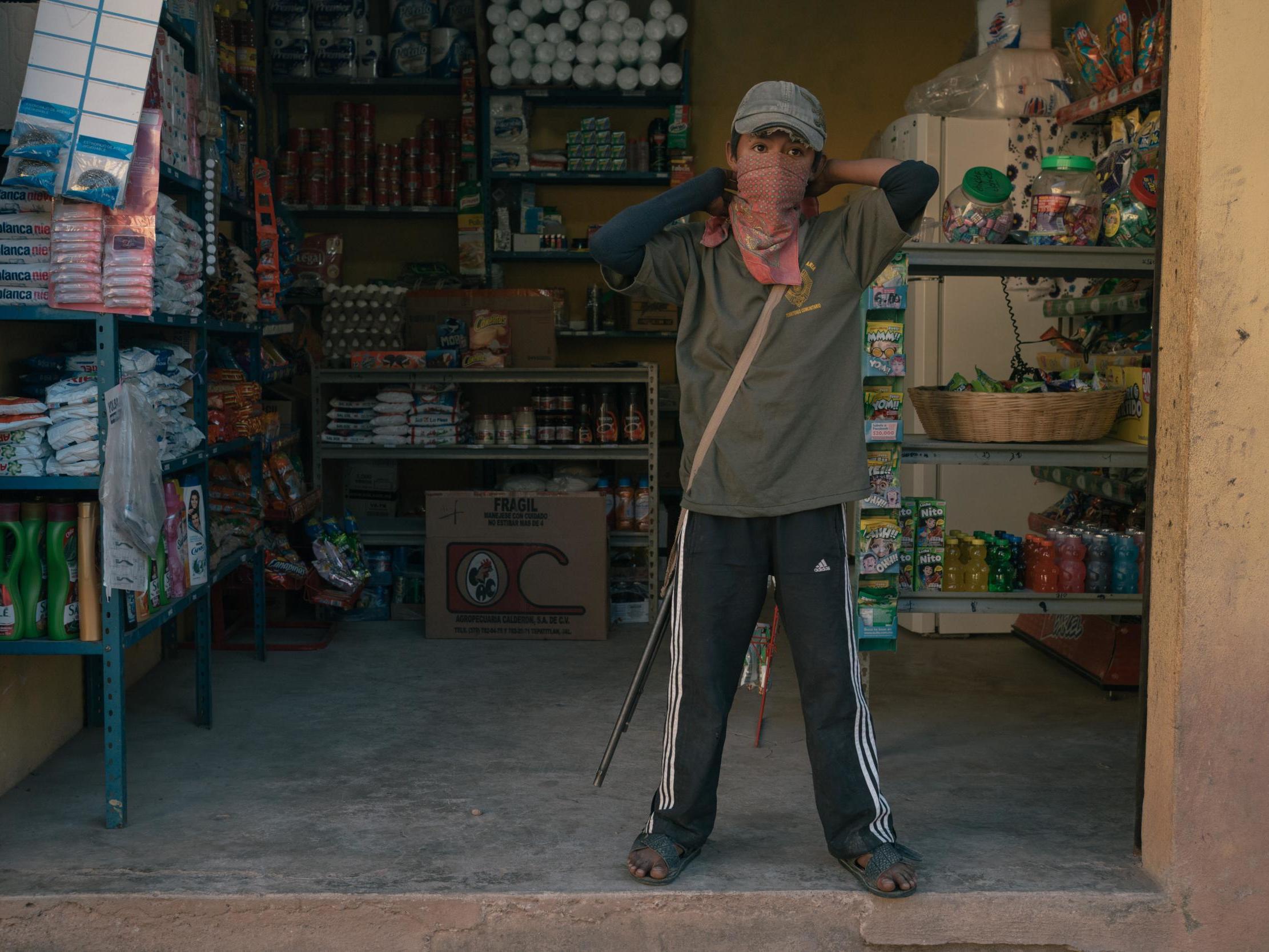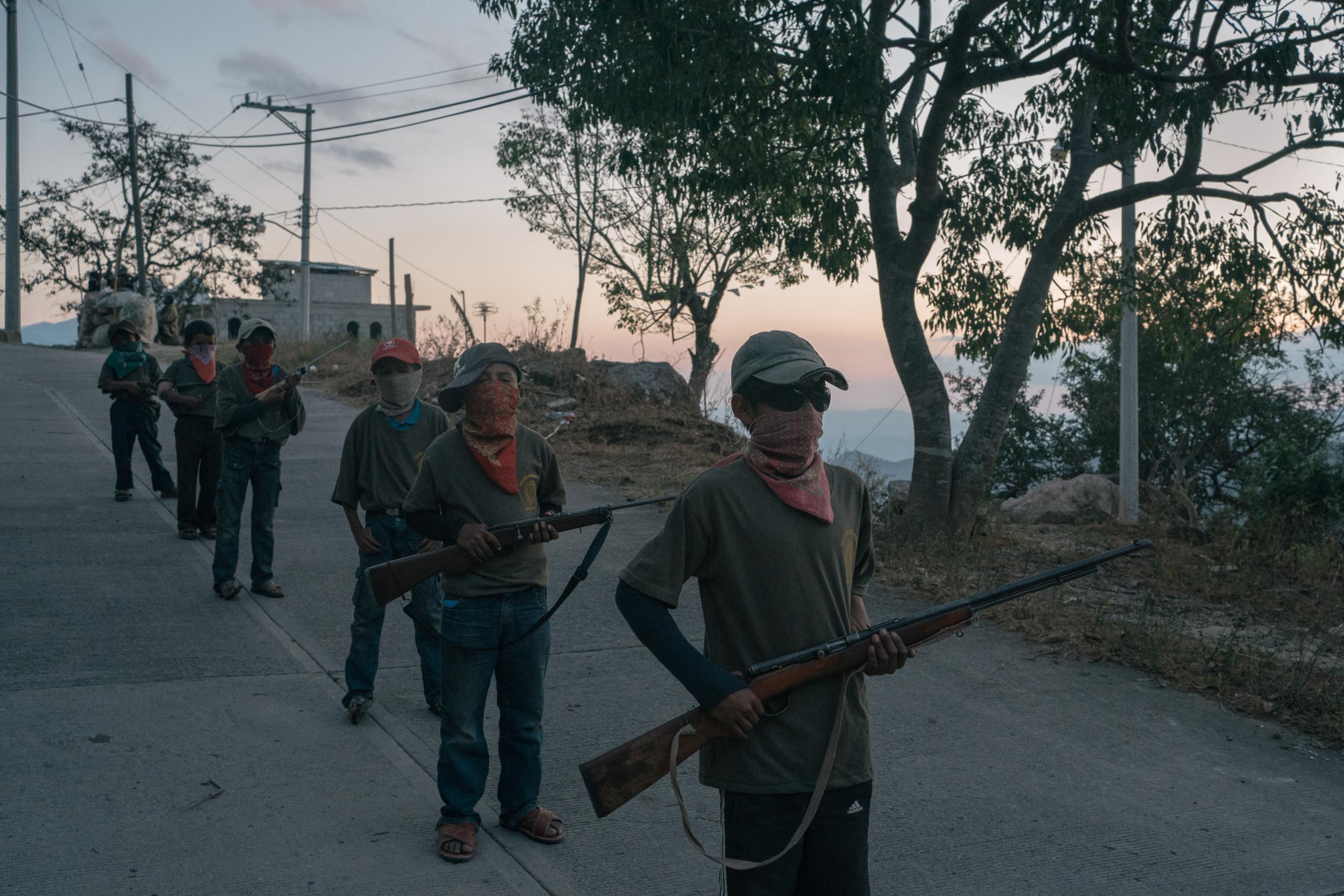The Independent's journalism is supported by our readers. When you purchase through links on our site, we may earn commission.
Inside the indigenous Mexican village were child soldiers protect the land
Terrorised by drug cartels, the youth of Ayahualtempa are being armed with rifles. But is it merely a desperate attempt at preservation or just media stunt, asks Kevin Sieff

Your support helps us to tell the story
From reproductive rights to climate change to Big Tech, The Independent is on the ground when the story is developing. Whether it's investigating the financials of Elon Musk's pro-Trump PAC or producing our latest documentary, 'The A Word', which shines a light on the American women fighting for reproductive rights, we know how important it is to parse out the facts from the messaging.
At such a critical moment in US history, we need reporters on the ground. Your donation allows us to keep sending journalists to speak to both sides of the story.
The Independent is trusted by Americans across the entire political spectrum. And unlike many other quality news outlets, we choose not to lock Americans out of our reporting and analysis with paywalls. We believe quality journalism should be available to everyone, paid for by those who can afford it.
Your support makes all the difference.Before he picked up a rifle and joined a squad of armed children, Alex wanted to become a schoolteacher. He’d teach anything – “whatever the principal asks” – because spending his days in a classroom sounded pretty good. He was 13, a student with a Teenage Mutant Ninja Turtles bicycle who got nervous around the girls in his high school. Then, in November, as violence surged in the mountains of Guerrero state, the men of Ayahualtempa decided it was time for their sons to take up arms.
Alex was handed a hunting rifle and told to show up for daily training on the village basketball court. He and his young comrades, some as young as six, march and crawl with loaded guns almost as tall as they are. Their uniforms say “Community Police” in yellow letters.
When the photographers started coming, the boys were told to cover their faces with handkerchiefs. Arming children to defend the town against a violent gang wasn’t a media stunt, Alex’s commanders insisted. Yet if the images drew the government’s attention to a place Mexico’s security forces had forgotten, it would be a triumph of its own.
But are the boys training to defend their village, or are they being paraded in front of visiting photographers to send a message to the government, a plea for more resources? Sometimes even Alex isn’t sure. What he knows is that the gun is heavy and loaded, and the training feels real enough to him. Alex’s father, Santos Martinez, looks at his son’s face, trying to gauge whether Alex is mature enough to join the force. “There was no fear in his eyes,” Martinez says. “That’s how I knew he was ready.”

Alex repeats the words of his commander: “I’m preparing to defend my village.”
Mexico suffered 35,588 homicides in 2019. It is another data point in a trend borne out across Ayahualtempa and thousands of towns like it: Every year, no matter who is in power, this country becomes more violent. But violence takes dramatically different forms across Mexico, a nation splintered by turf wars. In the northwestern capital of Culiacan, the Sinaloa cartel battles the country’s security forces with military-grade weapons. In Ayahualtempa, a village of 600 indigenous people, the community police carry ageing hunting rifles in their own war against a powerful drug cartel called Los Ardillos, which controls the neighbouring town.
The village has been ignored for decades, but it is hard to ignore a force of armed children
For years, Ayahualtempa has maintained its own defence force, dozens of armed men who patrol the village and man checkpoints and hold overwatch positions on the roofs of unfinished homes. Autodefensas, or self-defence forces, are legal in Guerrero state and recognised by the federal government. But over the past year, the local autodefensa, known as the Crac-PF, has been overwhelmed. 26 have been killed since the start of 2019 in the force’s territory, which includes Ayahualtempa and 15 other towns. Last month, 10 musicians from those towns traveling to a concert were shot and burned beyond recognition. One of them was 15 years old.
Alex’s high school is in what is considered to be enemy territory. He has stopped attending. Bernardino Sanchez Luna, founder of Crac-PF, says its leaders spoke among themselves and decided to allow the boys into the force. In recent months, the group of armed children grew more formal. Now there are 17 boys in matching T-shirts. Those under 12 get handmade toy guns. Those over 12 get working rifles.

“If the government can’t protect them, they need to be trained to defend themselves,” Sanchez Luna says.
Alex has seen the pictures of himself, rifle in hand, published in newspapers across Mexico. It is a strange kind of fame. He has never left the state of Guerrero, and now his face is on newsstands in the capital. His commander insists it is part of the strategy. He noticed that Crac-PF’s leaders began welcoming local journalists, who took photos of the boys during their training sessions. He heard Sanchez Luna talk about how the media could be used as a tool to convey the village’s problems – its demands for the state and federal governments. The village had been ignored for decades, but it would be hard to ignore a force of armed children.
By the time this correspondent arrived in Ayahualtempa this week, Alex’s suspicion had sharpened. “These journalists like you come, but I don’t know where they’re from,” he says. “How can I trust them?” He is sitting on the curb outside his family’s small convenience store, where he staffs the register now that he’s no longer in school. He kept his uniform and rifle behind a stack of plastic Pepsi bottles. Training starts at 5pm.

Sanchez Luna insists the boys aren’t being used as a tool to attract the attention of the media or the government. But he does admit that when journalists are in town, he holds training sessions earlier, because photographers and videographers have complained that the nighttime drills were too dark to record. He also calls the media “an important weapon for us”.
After a flurry of stories in Mexican news outlets, Crac-PF printed out a list of 29 demands for Mexico’s president, ranging from increased security to the installation of an ATM. President Andres Manuel Lopez Obrador has taken an interest in Ayahualtempa after seeing images of the armed children in the media. “Giving children weapons and taking videos is an act of cruelty,” he said last week.
35,588
Homicides in Mexico in 2019
But despite Lopez Obrador’s comments and a condemnation from Unicef, the children remain armed, and the government has not tried to intervene. The Guerrero state governor agreed to send a routine police patrol through the area. But that meant little to the people of Ayahualtempa, including Alex, who now watch, rifle in hand, as the heavily armed officers drive by. “We can’t trust them, either,” he says.
On Wednesday morning, Alex and his father leave their house for the village’s main checkpoint, a chain barrier that marked the division between Ayahualtempa and Hueycantenango, which they consider enemy territory.
They walk shoulder to shoulder, each holding a rifle. “Man the bunker,” Martinez says. Alex moves behind a barrier of tyres and concrete, his right hand near the gun’s trigger. He wears a pair of broken sandals, his feet sometimes slipping out as he walks. It is a moment that blurs the mission of the armed children. The force’s leaders say Alex and the other boys are merely “in training”, but here he is providing close protection for his father. Or is this, too, an elaborate attempt to attract news coverage that might draw the government’s attention to a place it had mostly abandoned? It is hard to tell.

“I don’t know how they can get the government’s attention aside by doing these sorts of things – or by dying, and even that will only get the authorities’ attention for a few days,” says Chris Kyle, an anthropologist at the University of Alabama at Birmingham who focuses on Guerrero.
In Mexico, stories emerge of self-defence groups recruiting children every few years. Accounts of drug cartels enlisting kids are even more common. But rarely has any group been this open about its effort. Another Guerrero autodefensa leader, Gonzalo Molina Gonzalez, likens the children to Mexico’s Ninos Heroes, the teenage folk heroes who died trying to repel the American invasion of Mexico City in 1847.
At the checkpoint, Martinez refuses to lower the chain for a truck driver. “They could work for Los Ardillos,” he mutters under his breath. Alex stands behind the bunker, watching as his former teachers walked to his old primary school. He doesn’t wave. His high school, Escuela Secundaria Tecnologica Cuauhtemoc 121, is only 200 yards away, but on the other side of the chain. A few months ago, he’d watched as a Crac-PF member carrying firewood was shot and killed a few feet from the school.

Not long after, the family decided it was too dangerous for him to continue going to class. They worried that anyone from Ayahualtempa could be targeted.
Alex’s older sister, Erica, refuses to stop going to school. She ran away to an aunt’s house. Their mother is torn. “I want my children to attend school, but not if that means their lives are at risk,” Justina says. “Every day I worry about my daughter.”
Alex’s teacher visited the family’s home this week to beg his parents to send Alex back to the classroom. Martinez says he refused. “I told the teacher, ‘Until the government provides some security, I’m not sending my son to school,’” he says.
Alex returns home from the bunker and set his rifle down on the floor. There was another training session that evening. More journalists have arrived. Alex repeats that he is training to defend his village, to prepare for a possible incursion. He can feel himself getting stronger and more capable. That’s what he was told, and that’s what he believes.
© Washington Post
Join our commenting forum
Join thought-provoking conversations, follow other Independent readers and see their replies
Comments